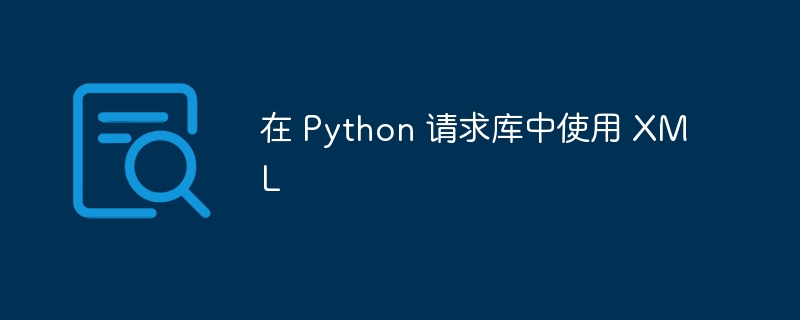在 Python 请求库中使用 XML
时间:2024-12-26 15:22:00 432浏览 收藏
知识点掌握了,还需要不断练习才能熟练运用。下面golang学习网给大家带来一个文章开发实战,手把手教大家学习《在 Python 请求库中使用 XML》,在实现功能的过程中也带大家重新温习相关知识点,温故而知新,回头看看说不定又有不一样的感悟!

本文介绍如何使用Python的requests库和xml.etree.ElementTree模块解析XML数据。XML(可扩展标记语言)用于存储结构化数据。 常见的XML应用包括站点地图和RSS订阅。
以下是一个XML文件示例:
import requests
import xml.etree.ElementTree as ET
response = requests.get('https://www.w3schools.com/xml/simple.xml')
root = ET.fromstring(response.content)
for item in root.iterfind('food'):
print('Name: {}, Price: {}, Description: {}, Calories: {}'.format(
item.findtext('name'), item.findtext('price'), item.findtext('description'), item.findtext('calories')))
这将以更易读的格式打印输出。
XML文件示例来自w3schools。
希望本文对您有所帮助! 您可以通过你的赞助链接来支持我的工作。
本篇关于《在 Python 请求库中使用 XML》的介绍就到此结束啦,但是学无止境,想要了解学习更多关于文章的相关知识,请关注golang学习网公众号!
相关阅读
更多>
-
501 收藏
-
501 收藏
-
501 收藏
-
501 收藏
-
501 收藏
最新阅读
更多>
-
355 收藏
-
397 收藏
-
107 收藏
-
293 收藏
-
496 收藏
-
497 收藏
-
295 收藏
-
416 收藏
-
284 收藏
-
313 收藏
-
387 收藏
-
401 收藏
课程推荐
更多>
-

- 前端进阶之JavaScript设计模式
- 设计模式是开发人员在软件开发过程中面临一般问题时的解决方案,代表了最佳的实践。本课程的主打内容包括JS常见设计模式以及具体应用场景,打造一站式知识长龙服务,适合有JS基础的同学学习。
- 立即学习 543次学习
-

- GO语言核心编程课程
- 本课程采用真实案例,全面具体可落地,从理论到实践,一步一步将GO核心编程技术、编程思想、底层实现融会贯通,使学习者贴近时代脉搏,做IT互联网时代的弄潮儿。
- 立即学习 516次学习
-

- 简单聊聊mysql8与网络通信
- 如有问题加微信:Le-studyg;在课程中,我们将首先介绍MySQL8的新特性,包括性能优化、安全增强、新数据类型等,帮助学生快速熟悉MySQL8的最新功能。接着,我们将深入解析MySQL的网络通信机制,包括协议、连接管理、数据传输等,让
- 立即学习 500次学习
-

- JavaScript正则表达式基础与实战
- 在任何一门编程语言中,正则表达式,都是一项重要的知识,它提供了高效的字符串匹配与捕获机制,可以极大的简化程序设计。
- 立即学习 487次学习
-

- 从零制作响应式网站—Grid布局
- 本系列教程将展示从零制作一个假想的网络科技公司官网,分为导航,轮播,关于我们,成功案例,服务流程,团队介绍,数据部分,公司动态,底部信息等内容区块。网站整体采用CSSGrid布局,支持响应式,有流畅过渡和展现动画。
- 立即学习 485次学习
